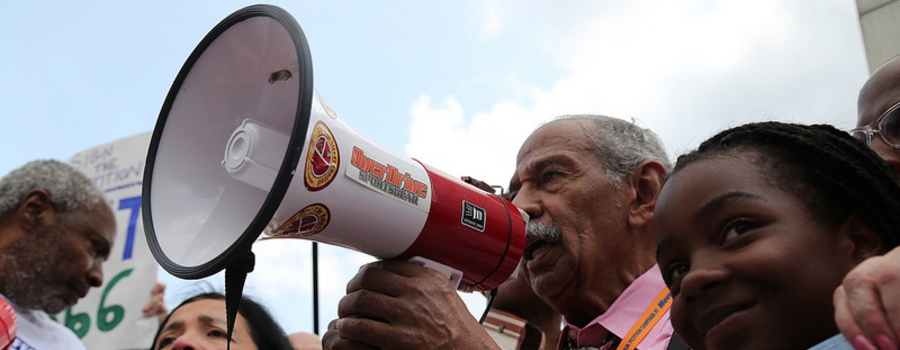
Photo: Rep. John Conyers, Jr. at a rally for clean water in Detroit, 2014.
Introduced by Rep. John Conyers to the 108th-115th Congresses (2003-2018). No companion legislation has been filed in the Senate.
Index of Information on the Expanded and Improved Medicare for All Act
- Details of the Expanded and Improved Medicare for All Act
- Analysis of the Expanded and Improved Medicare for All Act
- Information on the Expanded and Improved Medicare for All Act
Details of the Expanded and Improved Medicare for All Act
The original Expanded and Improved Medicare for All Act would cover all residents of the U.S. and U.S. territories with comprehensive healthcare benefits and no cost-sharing. The program would be administered nationally by the Department of Health and Human Services.
Institutional providers such as hospitals would be paid under global budgets, while physicians and other practitioners would be paid under fee-for-service or a salaried basis. A national fee schedule and prescription drug formulary would be established.
The bill does not include a complete financing proposal, but specifies that the program will be paid for via:
- an increase in the personal income tax for the top 5% of income-earners;
- a payroll tax; and
- a "Tobin tax" on financial transactions.
Analysis of the Expanded and Improved Medicare for All Act
In 2013, economist Gerald Friedman published a report titled "Funding HR 676: The Expanded and Improved Medicare for All Act," which developed financing options for H.R. 676 and analyzed the economic impacts of implementation.
Friedman's analysis found that "Under the single-payer system created by HR 676, the U.S. could save an estimated $592 billion annually by slashing the administrative waste associated with the private insurance industry ($476 billion) and reducing pharmaceutical prices to European levels ($116 billion). In 2014, the savings would be enough to cover all 44 million uninsured and upgrade benefits for everyone else."
Information on the Expanded and Improved Medicare for All Act
Read the full bill from 115th Congress (2017-2018).
Read the summary of H.R. 676 from the 115th Congress (2017-2018).
See the list of 119 Congressional cosponsors for the 115th Congress (2017-2018).
Read the full bill from 114th Congress (2015-2016).
Read the summary of H.R. 676 from the 114th Congress (2015-2016).
See the list of 62 Congressional cosponsors for the 114th Congress (2015-2016).
Read the full bill from 113th Congress (2013-2014).
Read the summary of H.R. 676 from the 113th Congress (2013-2014).
See the list of 63 Congressional cosponsors for the 113th Congress (2013-2014).
Read the full bill from 112th Congress (2011-2012).
Read the summary of H.R. 676 from the 112th Congress (2011-2012).
See the list of 77 Congressional cosponsors for the 112th Congress (2011-2012).
Read the full bill from 111th Congress (2009-2010).
Read the summary of H.R. 676 from the 111th Congress (2009-2010).
See the list of 87 Congressional cosponsors for the 111th Congress (2009-2010).
Read the full bill from 110th Congress (2007-2008).
Read the summary of H.R. 676 from the 110th Congress (2007-2008).
See the list of 93 Congressional cosponsors for the 110th Congress (2007-2008).
Read the full bill from 109th Congress (2005-2006).
Read the summary of H.R. 676 from the 109th Congress (2005-2006).
See the list of 78 Congressional cosponsors for the 109th Congress (2005-2006).
Read the full bill from 108th Congress (2003-2004).
Read the summary of H.R. 676 from the 108th Congress (2003-2004).
See the list of 38 Congressional cosponsors for the 108th Congress (2003-2004).
